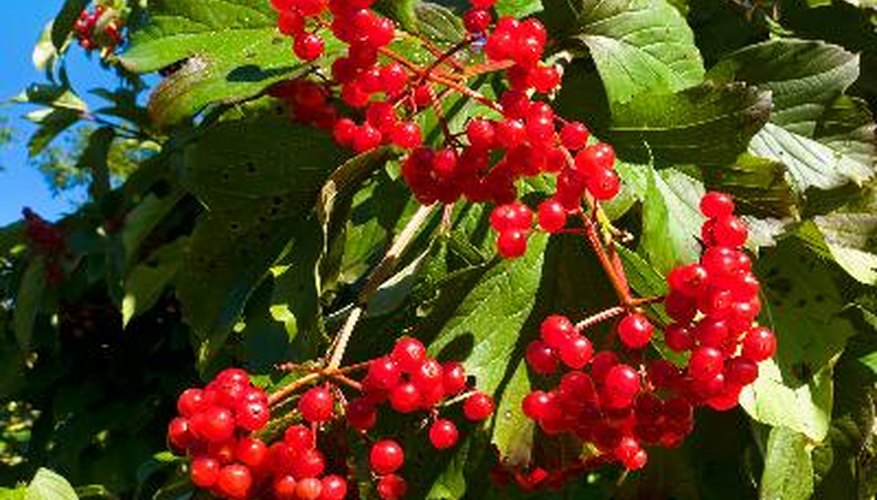Viburnum (Viburnum spp) trees and shrubs have dense green foliage and showy, often fragrant, white or pink spring blooms. Many cultivars' berries bring splashes of yellow, orange, pink, red, blue or black to the autumn garden. The bird-attracting berries complement the plants' red to purple fall leaves. European cranberry bush (V. opulus) and snowball (V. opulus var. sterilis) viburnums -- two of the most widely grown varieties -- are highly susceptible to leaf curl aphid infestations.
Identification
Adult snowball aphids (Neoceruraphis viburnicola, Ceruraphis viburnicola) first appear on viburnum shrubs stems as pale blue to grey, white-dusted insects. Feeding insects develop a darker green to greenish-blue colour. Snowball aphid larvae are white to pale green. Leaf curl aphids develop wings only when they are ready to migrate from the viburnums to another host plant.
- Adult snowball aphids (Neoceruraphis viburnicola, Ceruraphis viburnicola) first appear on viburnum shrubs stems as pale blue to grey, white-dusted insects.
Life Cycle
The viburnum leaf curl aphid's eggs overwinter on the shrubs' buds and twigs. The larvae hatch and feed on the newly opened spring buds before attaching themselves to the stems and -- without mating -- producing live larvae. Asexual reproduction lets the aphids produce several generations in a few weeks. The insects feed for up to two months before the entire population develops wings and migrate to a secondary, unidentified host plant. They return in early fall and give birth to female larvae. Males arrive shortly after that to mate. The females lay more eggs to overwinter on the viburnum's buds and twigs.
- The viburnum leaf curl aphid's eggs overwinter on the shrubs' buds and twigs.
Symptoms
Curling, misshapen leaves are the classic symptoms of leaf curl aphid infestation. The fluid-sucking insects may also cause severely twisted or bent branches. In large enough numbers, they can consume enough sap to stop a viburnum's growth. Aphids also secrete a sticky, clear waste called honeydew. Honeydew attracts a fungus called sooty mould. As sooty mould feeds on the honeydew, it covers the shrub's leaves with a grey to black, powdery coating. This coating may interfere with photosynthesis and further weaken the viburnum.
- Curling, misshapen leaves are the classic symptoms of leaf curl aphid infestation.
- As sooty mould feeds on the honeydew, it covers the shrub's leaves with a grey to black, powdery coating.
Natural Control
High-pressure spray with a garden hose is often sufficient to remove light leaf curl aphid infestations and honeydew. Ladybirds, parasitic wasps, lacewings and syrphid flies all attack leaf curl aphids. They may be enough to control mild infestations. Check for their presence before resorting to chemical insecticides as a control measure.
- High-pressure spray with a garden hose is often sufficient to remove light leaf curl aphid infestations and honeydew.
Horticultural Oil Control
Spray your viburnums with plant-based horticultural oil before they emerge from dormancy in early spring. These oils will prevent the eggs overwintering on the plants' twigs and buds from hatching.
Chemical Control
Systemic chemical insecticides applied to the leaves or soil and transported into the viburnums are most effective against leaf curl aphid. Acephate- and imidacloprid-based systemic insecticides are commercially available to homeowners.
